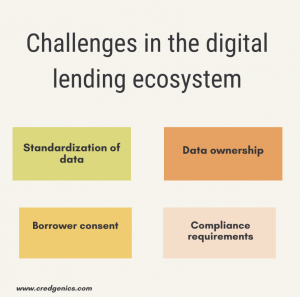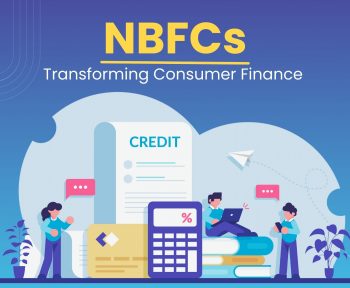The paradigm shift towards digital lending has led to enhanced convenience and easy accessibility for customers. However, this transformation has had its share of difficulties, with the key one among them being data security. As financial institutions increasingly embrace digital platforms to facilitate lending processes, the safeguarding of sensitive information has become a paramount concern. In order to prioritize data security and successfully navigate digital lending challenges, it is necessary to have a comprehensive strategy and put in place a series of measures that enable banks and other non-banking lending companies to maintain customer trust, ensure regulatory compliance, and drive sustainable growth.
The rise of digital lending
As per a PwC report, the digital lending market in India will grow to 48%, to reach $350 billion in 2023. Digital lending platforms have redefined the lending landscape by leveraging technology to streamline the loan application and approval processes. Borrowers can now apply for loans, submit documentation, and receive approvals without the need for physical visits to lender’s branch offices. This convenience has remodeled the borrowing experience, made credit more accessible and convenient. Simultaneously, newer lending models such as peer-to-peer lending, co-lending, and embedded finance are helping lenders tap a larger number of market segments. Large volumes of customer data acquired as a result necessitate the implementation of robust security practices.
Challenges in the digital lending ecosystem
Despite the benefits, digital lending also presents unique challenges, chief among them being data security. Digital lending platforms handle a vast amount of sensitive borrower information, ranging from personal identification details to financial records. Cyberattacks, data breaches, and identity theft are constant threats that can undermine the trust borrowers place in these platforms. Other digital lending challenges include:
- Standardization of data: Lending institutions rely on multiple sources of data, including social media platforms and mobile networks, to gather information about existing and potential customers’ spending habits and preferences. With huge volumes of data, lenders need to extract actionable insights to make this data work for them. Therefore, they need to further streamline the formats and process the data in several platforms to translate it into actionable metrics.
- Data ownership: There may be multiple entities involved in the ownership of data. Fintech lenders acquire data from customers as well as ecosystem players including banks and NBFCs, therefore, ownership and accountability might at times become diluted. Clarifying this distinction is essential in determining the extent of responsibility and accountability for fintechs, banks, and NBFCs.
- Borrower consent: The Reserve Bank of India’s master directives on Know-Your-Customer underscore the need for obtaining explicit consent from individuals before obtaining, saving, and sharing their personal information. However, the extent to which such content is obtained by the lending and collections entities is something that needs to be looked at closely. Fintech companies interacting with customers regularly need to strike a balance between obtaining consent in a cordial manner while ensuring that the data acquired is auditable and transparent.
- Compliance requirements: Fintech companies and lending institutions are subject to regulatory protocols to ensure compliance with data privacy and audit requirements. Adherence to these standards is also a baseline expectation of borrowers and helps establish trust.

Combating challenges through data security
Some of the technological developments that help combat the challenges of digital lending are:
- Encryption: Implementation of end-to-end encryption for data transmission and storage ensures that data is protected from unauthorized access, both during transit and when stored in databases.
- Secure authentication: Using strong authentication methods such as multi-factor authentication (MFA) ensures that only authorized individuals can access and transact on the platform.
- Regular security audits: Frequent security audits and vulnerability assessments help tech teams identify and address potential weaknesses in the digital lending platform.
- Employee training: Training the employees on best practices for data security, including recognizing phishing attempts and avoiding risky behaviors that could compromise sensitive data, is imperative to ensuring the protection of data.
- Privacy policies and consent: Clearly communicating privacy policies to customers and obtaining their explicit consent for data collection and usage allows customers to control their data preferences.
- Data backups: Regularly backing up data and ensuring that backups are stored securely helps in the event of data loss due to technical issues or security breaches.
- Incident response plan: Having a well-defined incident response plan in place to address security breaches promptly and effectively is necessary for the overall security of the data. This includes steps for containment, communication, and recovery.
- Regulatory compliance: Lenders need to ensure that the digital lending platform complies with relevant data protection regulations, or local financial regulations, depending on the location and nature of operations.
Benefits of prioritizing data security to meet digital lending challenges
- Building Trust: Data breaches can lead to reputational damage and a loss of customer trust. Prioritizing data security sends a clear message to borrowers that their information is handled with the utmost care, fostering trust and customer loyalty.
- Regulatory Compliance: Stricter regulations are being enacted to protect consumer data. Platforms that prioritize data security are better equipped to navigate regulatory requirements without incurring penalties.
- Sustainable Growth: A secure digital lending platform attracts borrowers seeking a safe and convenient borrowing experience. As the platform’s reputation grows, so does its borrower base, leading to sustainable growth.
Conclusion
In the digital lending era, data security isn’t just a technical requirement; it’s a corel pillar of success. Digital lending challenges and opportunities demand a comprehensive approach to data security that encompasses encryption, authentication, compliance, and user education. By prioritizing data security, digital lending platforms can foster trust, ensure regulatory compliance, and create an environment where borrowers feel safe accessing credit. As technology continues to reshape financial services, safeguarding data integrity will remain a critical imperative that can set successful digital lending platforms apart from their competitors.
FAQs:
1. What is the biggest security concern with digital lending platforms?
The biggest security concern with digital lending platforms is the potential for data breaches and identity theft. These platforms handle a significant amount of sensitive personal and financial information from borrowers, including social security numbers, bank account details, and other confidential data. If not properly secured, this data can be vulnerable to cyberattacks, hacking, and unauthorized access. A breach could lead to severe consequences, including financial losses for borrowers, reputational damage for the lending platform, and legal and regulatory implications. Therefore, robust cybersecurity measures, data encryption, and stringent access controls are essential to safeguarding both borrower information and the platform’s integrity.
2. Why is there a need for lenders to prioritize data protection?
Lenders need to prioritize data protection for several important reasons:
- Protection of Sensitive Information: Lenders collect and store a vast amount of sensitive financial and personal information from borrowers. This includes details like citizen identification number, income, credit history, and more. If this information falls into the wrong hands, it can lead to identity theft, fraud, and financial losses for borrowers.
- Regulatory Compliance: Financial institutions, including lenders, are often subject to strict regulations and guidelines regarding data protection. Failing to comply with these regulations can result in legal penalties, fines, and reputational damage.
- Customer Trust: Data breaches can severely damage a lender’s reputation and erode the trust that borrowers and clients have in the institution. A breach can lead to customers choosing to take their business elsewhere, causing financial and reputational harm.
- Financial Losses: Data breaches can lead to direct financial losses, including costs associated with breach notification, legal actions, and remediation efforts. Additionally, lenders can incur costs related to monitoring and assisting affected customers to prevent further damage.
- Operational Continuity: A significant data breach can disrupt a lender’s operations, leading to downtime, loss of business, and disruptions in customer service. Restoring systems and services after a breach can be time-consuming and costly.
- Risk Management: Effective data security measures help lenders identify and mitigate potential risks related to cyberattacks, hacking, and unauthorized access. Proactive risk management is crucial for maintaining the stability and sustainability of the lending business.
3. What is digital lending?
Digital lending refers to the process of originating, underwriting, and disbursing loans using digital platforms and technology, often without the need for traditional physical paperwork or in-person interactions. It involves the use of online channels, automation, data analytics, and algorithms to facilitate the entire lending lifecycle, from loan application to approval and fund disbursement. Digital lending aims to streamline and expedite the lending process, making it more convenient and accessible for both borrowers and lenders. It can encompass various types of loans, including personal loans, business loans, mortgages, and more.




